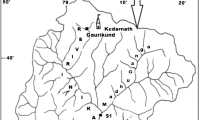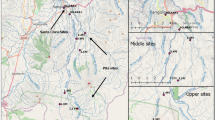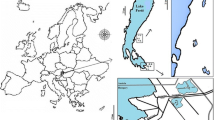Abstract
Mediterranean coastal areas are characterised by heavily transformed landscapes and an ever-increasing number of ponds are subjected to strong alterations. Although benthic diatoms and macroinvertebrates are widely used as indicators in freshwater ecosystems, little is still known about the diatom communities of lowland freshwater ponds in the Mediterranean region, and, furthermore, there are few macroinvertebrate-based methods to assess their ecological quality, especially in Italy. This article undertakes an analysis of benthic diatom and macroinvertebrate communities of permanent freshwater ponds, selected along a gradient of anthropogenic pressures, to identify community indicators (taxa and/or metrics) useful to evaluate the effect of human impacts. A series of 21 ponds were sampled along Tyrrhenian coast in central Italy. Five of these ponds, in a good conservations status and surrounded by woodland were selected as ‘reference sites’ for macroinvertebrates and epipelic diatoms. The remaining sixteen ponds were located in an agricultural landscape subject to different levels of human impact. The total number of macroinvertebrate taxa found in each pond was significantly higher in reference sites than in both the intermediate and heavily degraded ones, whereas the diatom species richness did not result in a good community variable to evaluate the pond ecological quality. The analysis revealed a substantial difference among the compositions of diatom communities between reference ponds and degraded ponds. The former were characterised by the presence of several species belonging to genera, such as Pinnularia sp., Eunotia sp., Stauroneis sp., Neidium sp., all of which were mostly absent from degraded ponds. Furthermore, the taxonomic richnesses of some macroinvetebrate groups (Odonata, Ephemeroptera, Trichoptera, Coleoptera), and taxa composition attributes of macroinvertebrate communities (total abundance, percentages of top three dominant taxa, percentages of Pleidae, Ancylidae, Hirudinea, Hydracarina) significantly correlated with variables linked with anthropogenic pressures. The results of the investigation suggested that diatoms tended more to reflect water chemistry through changes in community structure, whereas invertebrates responded to physical habitat changes primarily through changes in taxonomic richness. The methodologies developed for the analysis of freshwater benthic diatom and macroinvertebrate communities may have a considerable potential as a tool for assessing the ecological status of this type of water body, complying with the European Union Water Framework Directive 2000/60/EC.






Similar content being viewed by others
References
Alba-Tercedor, J. & A. Sánchez-Ortega, 1988. Un metodo rapido y simple para evaluar le calidad biologicas de las aguas corrientes basado en el de Hellawell (1978). Limnetica 4: 51–56.
APAT, 2008a. Protocollo di campionamento e analisi delle diatomee bentoniche dei corsi d’acqua. In APAT (ed.). Metodi Biologici per le acque dolci. Parte I [available on line http://www.apat.gov.it/site/it-IT/APAT/Pubblicazioni/Altre_Pubblicazioni.html].
APAT, 2008b. Protocollo di campionamento dei macroinvertebrati bentonici dei corsi d’acqua guadabili. In APAT (ed.). Metodi Biologici per le acque dolci. Parte I [available on line http://www.apat.gov.it/site/it-IT/APAT/Pubblicazioni/Altre_Pubblicazioni.html].
Apfelbeck, R. S., 2001. Development of biocriteria for wetland in Montana. In Rader, R. B., D. P. Batzer & S. A. Wissinger (eds), Bioassessment and Management of North American Freshwater Wetlands. Wiley, New York.
APHA (American Public Health Association), 1998. Standard methods for Examination of water and waste water. American Public Health Association, Washington, DC.
Armitage, P. D., D. Moss, J. F. Wright & M. T. Furse, 1983. The performance of a new biological water quality score system based on macroinvertebrates over a wide range of unpolluted running-water sites. Water Research 17: 333–347.
Bazzanti, M., S. Baldoni & M. Seminara, 1996. Invertebrate macrofauna of a temporary pond in Central Italy: composition, community parameters and temporal succession. Archiv fu¨r Hydrobiologie 137: 77–94.
Biggs J, Williams P, Whitfield M, Fox G, Nicolet P. 2000. Biological techniques of still water quality assessment. Phase 3. Method development. R&D Technical Report E110, Environment Agency, Bristol.
Biggs, J., P. Williams, M. Whitfield, P. Nicolet & A. Weatherby, 2005. 15 years of pond assessment in Britain: results and lessons learned from the work of Pond Conservation. Aquatic Conservation: Marine and Freshwater Ecosystems 15: 693–714.
Blanco, S., L. Ector & E. Bécares, 2004. Epiphytic diatoms as water quality indicators in Spanish shallow lakes. Vie Milieu 54: 71–79.
Cantonati, M., E. Bertuzzi, R. Gerecke, K. Ortler & D. Spitale, 2005. Long-term ecological research in springs of the Italian Alps: six years of standardised sampling. Verhangen International Verein Limnology 29: 907–911.
Cantonati, M., R. Gerecke & E. Bertuzzi, 2006. Spring of the Alps—sensitive ecosystems to environmental change: from biodiversity assessments to long-term studies. Hydrobiologia 562: 59–96.
Carrino-Kyker, S. R. & A. K. Swanson, 2007. Seasonal physicochemical characteristics of thirty northern Ohio temporary pools along gradients of GIS-delineated human land-use. Wetlands 27: 749–760.
CEC, 2000. Council of European Communities Directive 2000/60/EEC of 23 October 2000 establishing a framework for community action in the field of water policy. Official Journal of European Communities, L327/1.
CEC, 2005. Common Implementation Strategy for the Water Framework Directive (2000/60/EC). Wetlans Horizontal Guidance. Guidance Document N12. The role of wetlands in the Water Framework Directive. Official Journal of European Communities, Luxembourg.
Chao, A., 1984. Nonparametric estimation of the number of classes in a population. Scandinavian Journal of Statistics 11: 265–270.
Chessman, B. C., K. A. Fryirsb & G. J. Brierley, 2006. Linking geomorphic character, behaviour and condition to fluvial biodiversity: implications for river management. Aquatic Conservation: Marine and Freshwater Ecosystems 16: 267–288.
Chipps, S. T., D. E. Hubbard, K. B. Werlin, N. J. Haugerud, K. A. Powell & J. Thompson, 2006. Association between wetland disturbance and biological attributes in floodplain wetlands. Wetlands 26: 497–508.
Cohen, A. S., R. Bills, C. Z. Cocquyt & A. G. Caljon, 1993. The impact of sediment pollution on biodiversity in Lake Tanganyika. Conservation Biology 7: 667–677.
Connell, J. H., 1978. Diversity in tropical rain forests and coral reefs. Science 199: 1302–1310.
Della Bella, V., M. Bazzanti & F. Chiarotti, 2005. Macroinvertebrate diversity and conservation status of Mediterranean ponds in Italy: water permanence and mesohabitat influence. Aquatic Conservation: Marine and Freshwater Ecosystems 15: 583–600.
Della Bella, V., C. Puccinelli, S. Marcheggiani & L. Mancini, 2007. Benthic diatom communities and their relationship to water variables in wetlands of central Italy. Annales de Limnologie/International Journal of Limnology 43(2): 89–99.
Della Bella, V., M. Bazzanti, M. G. Dowgiallo & M. Iberite, 2008. Macrophyte diversity and physico-chemical characteristics of Tyrrhenian coast ponds in central Italy: implications for conservation. Hydrobiologia 597: 85–95.
Dell’Uomo, A., 2004. L’Indice Diatomico di Eutrofizzazione/Polluzione (EPI-D) nel monitoraggio delle acque correnti Linee Guida. APAT, CTN AIM, Roma.
DeNicola, D. M. & E. Eyto, 2004. Using epilithic algal communities to assess trophic status in Irish lakes. Journal of Phycology 40: 481–495.
De Pauw, N. & G. Vanhooren, 1983. Method for biological quality assessment of watercourses in Belgium. Hydrobiologia 100: 153–168.
EN 13946, 2003. Water quality. Guidance standard for the routine sampling and pre-treatment of benthic diatom samples from rivers. European Committee for Standardization, Brussels.
EN 14407, 2004. Water quality. Guidance standard for the identification, enumeration and interpretation of benthic diatom samples from running waters. European Committee for Standardization, Brussels.
EPCN, 2008. The Pond Manifesto. European Pond Conservation Network [available at www.europeanponds.org].
Feio, M. J., S. F. P. Almeida, S. C. Craveiro & A. J. Calado, 2007. Diatoms and macroinvertebrates provide consistent and complementary information on environmental quality. Fundamental and Applied Limnology/Archiv für Hydrobiologie 169: 247–258.
Gaiser, E., A. Wachnicka, P. Ruiz, F. Tobias & M. Ross, 2005. Diatom indicators of ecosystem change in subtropical coastal wetlands. In Bortone, S. A. (ed.), Estuarine Indicators. CRC Press, Boca Raton, FL: 127–144.
Gell, P., I. R. Sluiter & J. Fluin, 2002. Seasonal and interannual variations in diatom assemblages in Murray River connected wetlands in north-west Victoria, Australia. Marine & Freshwater Research 53: 981–992.
Gerecke, R. & E. O. Lehmann, 2005. Towards a long term monitoring of Central European water mite faunas (Acari: Hydracnidia and Halacaridae)—considerations on the background of data from 1900 to 2000. Limnologica 35: 45–51.
Ghetti, P.F., 1997. Indice Biotico Esteso (IBE). I macroinvertebrati nel controllo della qualità degli ambienti di acque correnti. Provincia Autonoma di Trento.
Helgen, J. C. & M. Gernes, 2001. Monitoring the condition of wetlands: indexes of biological integrity using invertebrates and vegetation. In Rader, R. B., D. P. Batzer & S. A. Wissinger (eds), Bioassessment and Management of North American Freshwater Wetlands. Wiley, New York: 167–185.
Hellawell, J. M., 1986. Biological Indicators of Freshwater Pollution and environmental management. Elsevier, New York.
Hering, D., O. Moog, L. Sandin & P. F. M. Verdonschot, 2004. Overview and application of the AQEM assessment system. Hydrobiologia 516: 1–20.
Hicks, A. L. & E. J. Nedeau, 2000. New England freshwater wetlands invertebrate biomonitoring protocol (NEFWIBP). A manual for volunteers. University of Massachusetts, Executive Office of Environmental Affairs, Massachusetts.
Hill, B. H., A. T. Herlihy, P. R. Kaufmann, R. J. Stevenson, F. H. McCornick & C. B. Johnson, 2000. Use of periphyton assemblage data as an index of biotic integrity. Journal of the North American Benthological Society 19: 50–67.
IRSA, 1994. Metodi Analitici per le Acque. Istituto Poligrafico e Zecca dello Stato, CNR, Rome.
Kelly, M. G., A. Cazaubon, E. Coring, A. Dell’Uomo, L. Ector, B. Goldsmith, H. Guasch, J. Hurlimann, A. Jarlman, B. Kawecka, J. Kwandrans, R. Laugaste, E. A. Lindstrom, M. Leitao, P. Marvan, J. Padisàk, E. Pipp, J. Prygiel, E. Rott, S. Sabater, H. van Dam & J. Vizinet, 1998. Recommendations for the routine sampling of diatoms for water quality assessments in Europe. Journal of Applied Phycology 10: 215–224.
King, L., G. Clarke, H. Bennion, M. Kelly & M. Yallop, 2006. Recommendations for sampling littoral diatoms in lakes for ecological status assessments. Journal of Applied Phycology 18: 15–25.
Krammer, K., 2000. The genus Pinnularia. In Lange-Bertalot, H. (ed.), Diatoms of European Inland Waters and Comparable Habitats, Vol. 1. A.R.G. Gantner Verlag, Germany.
Krammer, K. & H. Lange-Bertalot, 1986. Bacillariophyceae. Teil: Naviculaceae; Bacillariaceae, Epithemiaceae, Surirellaceae; Centrales, Fragilariaceae, Eunotiaceae; Achnathaceae. Kritische Erganzungen zu Navicula und Gomphonema; and french translation of the keys. Süβwasserflora von Mitteleuropa, 2/1, Fischer, Stuttgart.
Krammer, K. & H. Lange-Bertalot, 1988. Bacillariophyceae. Teil: Naviculaceae; Bacillariaceae, Epithemiaceae, Surirellaceae; Centrales, Fragilariaceae, Eunotiaceae; Achnathaceae. Kritische Erganzungen zu Navicula und Gomphonema; and french translation of the keys. Süβwasserflora von Mitteleuropa, 2/2, Fischer, Stuttgart.
Krammer, K. & H. Lange-Bertalot, 1991a. Bacillariophyceae. Teil: Naviculaceae; Bacillariaceae, Epithemiaceae, Surirellaceae; Centrales, Fragilariaceae, Eunotiaceae; Achnathaceae. Kritische Erganzungen zu Navicula und Gomphonema; and french translation of the keys. Süβwasserflora von Mitteleuropa, 2/3, Fischer, Stuttgart.
Krammer, K. & H. Lange-Bertalot, 1991b. Bacillariophyceae. Teil: Naviculaceae; Bacillariaceae, Epithemiaceae, Surirellaceae; Centrales, Fragilariaceae, Eunotiaceae; Achnathaceae. Kritische Erganzungen zu Navicula und Gomphonema; and french translation of the keys. Süβwasserflora von Mitteleuropa, 2/4, Fischer, Stuttgart.
Krammer, K. & H. Lange-Bertalot, 2000. Bacillariophyceae. Teil: Naviculaceae; Bacillariaceae, Epithemiaceae, Surirellaceae; Centrales, Fragilariaceae, Eunotiaceae; Achnathaceae. Kritische Erganzungen zu Navicula und Gomphonema; and french translation of the keys. Süβwasserflora von Mitteleuropa, 2/5, Fischer, Stuttgart.
Lange-Bertalot, H., 2001. Navicula sensu stricto: 10 genera separated from Navicula sensu stricto, Frustulia. In Lange-Bertalot, H. (ed.), Diatoms of Europe: Diatoms of the European Inland Waters and Comparable Habitats. A.R.G. Gantner Verlag, Germany.
Mackey, R. L. & D. J. Currie, 2001. The diversity-disturbance relationship: is it generally strong and peaked? Ecology 82: 3479–3492.
Mancini, L., 2005. Organization of biological monitoring in the European Union. In Ziglio, G., M. Siligardi & G. Flaim (eds), Biological Monitoring of Rivers. Wiley, London: 171–201.
Mancini, L. & G. Arcà (eds), 2000. Carta della qualità biologica dei corsi d’acqua della Regione Lazio. Regione Lazio, Istituto Superiore di Sanità, Roma.
Menetrey, N., L. Sager, B. Oertli & J. B. Lachavanne, 2005. Looking for metrics to assess the trophic state of ponds. Macroinvertebrates and amphibians. Aquatic Conservation: Marine and Freshwater Ecosystems 15: 653–664.
Nicolet, P., J. Biggs, G. Fox, M. J. Hodson, C. Reynolds, M. Withfield & P. Williams, 2004. The wetland plant and macroinvertebrate assemblages of temporary ponds in England and Wales. Biological Conservation 120: 265–282.
Oertli, B., D. Auderset Joye, E. Castella, R. Juge, A. Lehmann & J. B. Lachavanne, 2005. POLCH: a standirdized method for sampling and assessing the biodiversity ini ponds. Aquatic Conservation: Marine and Freshwater Ecosystems 15: 665–679.
Prygiel, J. & M. Coste, 2000. Guide metodologique pour la mise en oeuvre de l’Indice Biologique Diatomées, NFT 90-354.
Prygiel, J., M. Coste & J. Bukowska, 1999. Review of the major diatom-based techniques for the quality assessment of rivers. State of art in Europe. In Prygiel, J., B. A. Whitton & J. Bukowska (eds), Use of Algae for Monitoring Rivers, III. Proceeding of International Symposium, Douai, France 29 September-1 October 1997. Agence de l’Eau Artois-Picardie: 122–127.
Reynoldson, T. B., R. H. Norris, V. H. Resh, K. E. Day & D. M. Rosenberg, 1997. The reference condition: a comparison of multimetric and multivariate approaches to assess water quality impairment using benthic macroinvertebrates. Journal of the North American Benthological Society 16: 833–852.
Rossaro, B., L. Marziali, A. C. Cardoso, A. Solimini, G. Free & R. Giacchini, 2007. A biotic index using benthic macroinvertebrates for Italian lakes. Ecological Indicators 7: 412–429.
Sala, J., S. Gascòn, D. Boix, J. Gesti & X. D. Quintana, 2004. Proposal of a rapid methodology to assess the conservation status of Mediterranean wetlands and its application in Catalunya. Archive des Sciences 57: 141–152.
Solimini, A. G., M. Bazzanti, A. Ruggiero & G. Carchini, 2008. Developing a multimetric index of ecological integrity based on macroinvertebrates of mountain ponds in central Italy. Hydrobiologia 597: 109–123.
Stevenson, R. J., 1984. Epilithic and epipelic diatoms in the Sandusky River, with emphasis on species diversity and water pollution. Hydrobiologia 114: 161–175.
Stewart, P. M., J. T. Butcher & T. O. Swinford, 2000. Land use, habitat, and water quality effects on macroinvertebrate communities in three watersheds of a Lake Michigan associated marsh system. Aquatic Ecosystem Health and Management 3: 179–189.
Tangen, B. A., M. G. Butlerv & M. J. Ell, 2003. Weak correspondence between macroinvertebrate assemblages and land use in prairie pothole region wetlands, USA. Wetlands 23: 104–115.
Triest, L., P. Kaur, S. Heylen & N. De Pauw, 2001. Comparative monitoring of diatoms, macroinvertebrate and macrophytes in the Woluwe River (Brussels, Belgium). Aquatic Ecology 35: 183–194.
Trigal, C., F. Garcı´a-Criado & C. Ferna´ndez-Ala´ez, 2006. Among-habitat and temporal variability of selected macroinvertebrate based metrics in a Mediterranean shallow lake (NW Spain). Hydrobiologia 563: 371–384.
Trigal, C., F. Garcı´a-Criado & C. Ferna´ndez-Ala´ez, 2009. Towards a multimetric index for ecological assessment of Mediterranean flatland ponds: the use of macroinvertebrates as bioindicators. Hydrobiologia 618: 109–123.
Vafaei, R., 2004. Biology of Plea minutissima found in the central provinces of Iran. NABS Annual meeting, Vancouver, British Columbia, June 2004.
van Dam, H., 1982. On the use of measures of structure and diversity in applied diatom ecology. Nowa Hedwigia 73: 97–115.
Verneaux, V., J. Verneaux, A. Schmitt, C. Lovy & J. C. Lambert, 2004. The Lake Biotic Index (LBI): an applied method for assessing the biological quality of lakes using macrobenthos; the Lake Chaˆlain (French Jura) as an example. Annales de Limnologie/International Journal of Limnology 40: 1–9.
Wang, Y.-K., R. J. Stevenson, P. R. Sweet & J. DiFranco, 2006. Developing and testing diatom indicators for wetlands in the Casco Bay watershed, Maine, USA. Hydrobiologia 561: 191–206.
Watchorn, M. A., P. B. Hamilton, T. W. Anderson, H. M. Roe & R. T. Patterson, 2008. Diatoms and pollen as indicators of water quality and land-use change: a case study from the Oak Ridges Moraine, Southern Ontario, Canada. Journal of Paleolimnology 39: 491–509.
Wiederholm, T., 1980. Use of benthos in lake monitoring. Journal of the Water Pollution Control Federation 52: 537–547.
Williams, P., M. Whitfield, J. Biggs, S. Bray, G. Fox, P. Nicolet & D. Sear, 2004. Comparative biodiversity of rivers, streams, ditches and ponds in an agricultural landscape in Southern England. Biological Conservation 115: 329–341.
Wood, R. J., M. T. Greenwood & M. D. Agnew, 2003. Pond biodiversity and habitat loss in the UK. Area 35: 206–216.
Acknowledgements
The study was supported by a fellowship from Accademia Nazionale dei Lincei to V.D.B. We wish to thank E. Alleva for suggestions and continuing support. We thank J. Sala, S. Gascón and D. Boix for their help in the application of ECELS index. We are grateful to Luc Ector and to the instructors of the 1st Workshop ‘Ecology & taxonomy of benthic diatoms in oligotrophic freshwater habitats’ (Lake Tovel Limnological Station of the Trentino Nature Science Museum, 16–20 June 2008), in particular to H. Lange-Bertalot, R. Pienitz, B. Van de Vijver and K. Buczkò for their precious help in the taxonomic determination of some diatom species. We also thank, for their help in the field work, F. Russo, S. Ciadamidaro and C. Marinilli. We are also grateful to C. Rondinini for critical reading of the earlier version of the manuscript. Finally, we wish to thank the Presidential Estate of Castelporziano, Maremma Regional Park, Litorale Romano Natural State Reserve, LIPU Oasi Castel di Guido, Wood of Foglino, and landowners for the help in the identification of ponds and for granting us permission to conduct our research within their natural reserves and private properties. First version of this article was improved based on the suggestions of B. Oertli and two anonymous reviewers.
Author information
Authors and Affiliations
Corresponding author
Additional information
Guest editors: B. Oertli, R. Cereghino, A. Hull & R. Miracle
Pond Conservation: From Science to Practice. 3rd Conference of the European Pond Conservation Network, Valencia, Spain, 14–16 May 2008
Electronic supplementary material
Below is the link to the electronic supplementary material.
Rights and permissions
About this article
Cite this article
Della Bella, V., Mancini, L. Freshwater diatom and macroinvertebrate diversity of coastal permanent ponds along a gradient of human impact in a Mediterranean eco-region. Hydrobiologia 634, 25–41 (2009). https://doi.org/10.1007/s10750-009-9890-x
Published:
Issue Date:
DOI: https://doi.org/10.1007/s10750-009-9890-x




